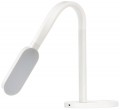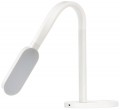Main power source
Standard power supply provided in the lamp design.
-
Net. Powered by a regular household 230V socket. This is the option provided by most table lamps: sockets provide unlimited runtime and are ubiquitous (and where they are not available, you will need a portable flashlight rather than a table lamp). The only significant drawback of this type of power supply is the presence of a wire; however, it usually does not create any noticeable inconvenience, and problems with reaching the outlet are rare and easily resolved.
—
Batteries. Powered by replaceable batteries (AA batteries, AAA batteries, etc.). Such batteries can be either disposable or rechargeable. Such power allows you to use the lamp without connecting to an outlet, and the batteries themselves can be quickly replaced when their charge is depleted (unlike built-in
batteries, see below). At the same time, table lamps are intended mainly for residential and work spaces, where there are no problems with sockets. At the same time, autonomous power supply inevitably limits the operating time of the lamp, and batteries in particular are suitable only for relatively low-power lighting sources. Therefore, this option is used only in cases where the wire is undesirable or inappropriate. For example, some children's's lamps with a night light function are powered by batteries (so that there are no unneces
...sary wires in the children's's room), as well as decorative models in an unusual design (so that the power cord does not spoil the appearance).
- Battery. In this case, we mean an original battery that does not belong to standard “battery” sizes and does not allow for quick replacement (sometimes it is not removable at all). Actually, the inability to quickly replace is precisely the main disadvantage of such power sources compared to the batteries described above. On the other hand, batteries can be made more capacious and at the same time more compact; they are easier to fit into the design of a lamp (even a very small one); and the fact that such food does not need to be purchased separately can also be considered an advantage. Thanks to this, batteries are found more often - both in original lamps, where wire is in principle undesirable, and in lamps for work purposes (mainly LED).
— USB port. Powered by standard USB port. This category of lamps will be appreciated mainly by laptop owners: when working with a laptop, the USB ports are in close proximity, and connecting lamps to such a connector is easier than looking for a socket and pulling a wire to it. However, such a device can also be connected to an outlet - just find a 230-to-USB adapter. USB adapters also exist for car cigarette lighters, so such a lamp can also be useful for mobile use - for example, when traveling outdoors or in the van of a mobile group (scientific, operational, etc.). And if necessary, you can power the lamp from a battery - a separate power bank or the same laptop. At the same time, in general, the scope of application of USB lamps is quite specific, and there are only a few of them produced.Maximum power
The maximum power of the light source allowed for a given lamp.
This parameter has different meanings depending on the light source (see the corresponding paragraph). It is most critical for models with sockets for replaceable light bulbs: the power of the light bulbs used should not exceed the maximum power of the lamp. Otherwise, it will overheat, and the consequences can be very unpleasant - even a fire. In this case, for models with several cartridges, the total power of all installed light sources is indicated. In order to determine the maximum permissible power of an individual light bulb, you need to divide the total limitation by the number of sockets. For example, in a model with 7 “seats” and a limit of 140 W, you can install bulbs of no more than 140/7 = 20 W.
It is also worth recalling that the actual brightness of the light bulb will depend not only on its power, but also on its type. Thus, at the same brightness, “energy-saving” fluorescent lamps have a power 3 to 5 times less than incandescent lamps, and LED light sources - 10 times less. Thus, low permissible power does not interfere with achieving high brightness.
As for table lamps with built-in LEDs, the maximum power for them corresponds to the actual power of the LED unit. You can roughly estimate the capabilities of such a lamp using the above formula - the brightness of the LED corresponds to the brightness of an incandescent lamp with 10 times more power. For example..., if you previously made do with a 60-watt light bulb, an 8-watt LED lamp will most likely be enough for you.
Wattage also determines the energy consumption of the lamp. However, it is not particularly high in table lamps, and in models with a replaceable socket, it also depends not on the maximum power of the lamp itself, but on the characteristics of the actually installed light bulbs.

